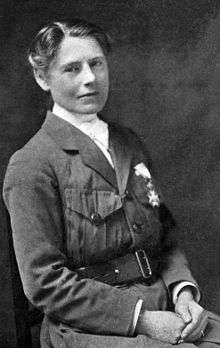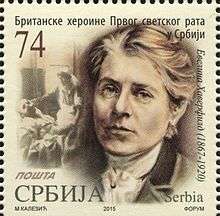Evelina Haverfield
Evelina Haverfield (9 August 1867 – 21 March 1920)[1] was a British suffragette and aid worker. In the early part of the 20th century, she was involved in Emmeline Pankhurst's militant women's suffrage organisation the Women's Social and Political Union. During World War I she worked as a nurse in Serbia. After the war, she returned to Serbia with her companion Vera Holme to set up an orphanage in Bajina Bašta, a town in the west of the country.[2]
Evelina Haverfield | |
|---|---|
 | |
| Born | Evilena Scarlett 9 August 1867 Kingussie, United Kingdom |
| Died | 21 March 1920 (aged 52) Bajina Bašta, Serbia |
| Nationality | British |
| Occupation | Social Activist, Suffragette |
| Spouse(s) | Henry Haverfield ( m. 1887–1895)John Balguy ( m. 1899) |

Early career
Evelina's birth is recorded as 'Honourable Evilena Scarlett' (with her first name spelled thus) born on 9 August 1867 at Inverlochy Castle, Kingussie in Scotland.[3][4] She was the third child of the 5 daughters and a son of William Frederick Scarlett, 3rd Baron Abinger and his wife Helen (Eileen) Magruder who was the daughter of a United States Navy Commodore.[4][5][6] Her childhood was divided between London and the Inverlochy estate.[7] In 1880 she went to school in Düsseldorf, Germany.[4] On 10 February 1887, at the age of 19, she married a Royal Artillery officer, Major Henry Wykeham Brooke Tunstall Haverfield, in Kensington, London, and the couple went to live at Sherborne, Dorset. Her husband was 20 years her senior.[4][7] The marriage was a happy one producing two sons, John Campbell Haverfield (born 1887) and Brook Tunstall Haverfield (born 1889) but Henry Haverfield died eight years later.[4][7]
Haverfield enjoyed a lifestyle not yet commonplace for women, for example, she rode a bicycle she called Pegasus.[7] Cycling was embraced by the suffragists as it was vehicle for 'fresh air' and freedom. The sense of liberation was dynamic during the Great War, when mobility was at a high premium and engendered equality. On 19 July 1899, she married John Henry Balguy, from a Derbyshire gentry family,[8] another Royal Artillery major, later a brigadier-general, later a Metropolitan Police magistrate,[9] and a friend of her late husband.[4][10] The ceremony took place in a Dorset hamlet called Caundle Marsh. The bride soon reverted to the name Haverfield and kept her home in Sherborne. On her wedding day, she wrote in her diary: 'I married Major Balguy with no intention of changing my name or mode of life in any way. He is an old friend of my darling Jack.'[11]
Haverfield's friendship with Vera Holme who lived with her in Devon from 1911, may have been more like a marriage, as a year after moving in, Holme made Haverfield her sole heir (including leaving her a bed with 'E.H.&V.H.' carved on it). In 1921, Haverfield's own will was refuted by her husband, it was said their marriage was 'an unsatisfactory union".[9]
During the Second Boer War, she travelled to South Africa for two years to act as assistant to her husband who was stationed there. She enjoyed being involved in the military zone and even took part in rifle practice.[7] While there she formed a retirement camp for horses.[4] After ten years, the couple separated, but did not divorce.[12]
Women's suffrage
Haverfield began to take an interest in politics and aligned herself with the moderate women's suffrage groups.[7] She joined the Sherborne branch of the National Union of Women's Suffrage Societies.[4] In 1908 she attended a rally at the Royal Albert Hall and started supporting the militant suffragettes, joining the Women's Social and Political Union (WSPU).[4] She took part in numerous protests and was arrested several times for obstructing and assaulting the police.[7]
In 1909 Haverfield took part in the Bill of Rights March.[7] Members of the WSPU, led by Emmeline Pankhurst, attempted to enter the House of Commons. They were blocked by the police and over 100 women were arrested, including Haverfield.[7] Following a WSPU demonstration in 1910 she was arrested for assaulting a police officer after hitting him in the mouth.[4][6] According to the charges brought against her, she had also said "It was not hard enough. Next time I will bring a revolver."[6] In 1911 she was among 200 women arrested in London for breaking windows and damaging government buildings during a public protest against the Manhood Suffrage bill. The Veto bill passing through the Commons was challenged several times by the Lords during efforts by the Liberal government to secure the provisions in their budgets in 1909 and 1910. The Parliament Act 1911 [13] Haverfield's part in this particular protest had been to attempt to disrupt a police cordon by leading police horses out of their rank.[6] In the same year Haverfield began a relationship with her fellow suffragette the actress Vera "Jack" Holme which lasted until Haverfield's death,[14] although during 1919 Holme was living in Kirkcudbright where she had an affair with the artist Dorothy Johnstone.[15] With cancer scientist Alice Laura Embleton, Vera Holme and Celia Wray Haverfield set up the private 'Foosack League' between themselves the membership of which was restricted to women and suffragists; the internal evidence suggests the Foosack League was a lesbian secret society.[16] Certainly, the four were close friends as evidenced by the many letters written between them, particularly during World War I.[17]
World War I
When World War I broke out in 1914, Haverfield became concerned with how women could help in the event of an invasion of the UK and founded the Women's Emergency Corps. In 1915 she volunteered to go abroad with the Scottish Women's Hospitals, joining Elsie Inglis in Serbia.[4][7] In early 1916, they were forced to leave Serbia following the German invasion.[4] Haverfield returned to England and gave press interviews about the situation in Serbia. In August, she travelled at Inglis' request to Dobrudja in Romania.[7] With Flora Sandes she founded the Hon. Evelina Haverfield's and Sert-Major Flora Sandes's Fund for Promoting Comforts for Serbian Soldiers and Prisoners.[6]
After the war
Following the end of the war, Evelina turned her attention to the orphaned Serbian children.[7] She travelled to Serbia with Holme and helped to build a children's health centre in Bajina Basta which was later named after her.[18] She died on 21 March 1920 of pneumonia and is buried in the cemetery at Bajina Basta.[2] Holme was left £50 a year for life by Haverfield [19] despite the challenge from Haverfield's husband.[9]
See also
References
- Burke, Bernard; Pirie-Gordon, Charles Harry Clinton (1937). Genealogical and heraldic history of the landed gentry: founded by the late Sir Bernard Burke. Band 1 (15. Auflage ed.). Shaw. p. 90.
- "Women's Reserve Ambulance – World War One". COHSE Britain's Health Service Union.
- "SR Birth Search Return for Scarlett 1865 – 1869". Scotland's People.
- Crawford, Elizabeth (September 2004). "Haverfield, Evelina (1867–1920)". Oxford Dictionary of National Biography. Oxford University Press. Retrieved 23 January 2010.
- "Lt.-Gen. William Frederick Scarlett, 3rd Baron Abinger". The Peerage.
- Crawford, Elizabeth (2001). The women's suffrage movement: a reference guide, 1866–1928. Routledge. p. 279. ISBN 0-415-23926-5.
- Gaddes, Boyce (22 August 2009). "The Life of Evelina Haverfield". FirstWorldWar.com. Retrieved 23 January 2010.
- A Genealogical and Heraldic History of the Landed Gentry of Great Britain and Ireland, fifth ed., vol. I, Sir Bernard Burke, 1871, p. 51, 'Balguy of Duffield' pedigree
- Atkinson, Diane (2018). Rise up, women! : the remarkable lives of the suffragettes. London: Bloomsbury. pp. 152–3. ISBN 9781408844045. OCLC 1016848621.
- "Lot 422, 13 September 2012". Orders, Decorations, Medals and Militaria (13 – 14 September 2012). Dix Noonan Webb. Retrieved 30 June 2010.
- Rise Up Women! The Remarkable Lives of the Suffragettes, Diane Atkinson, Bloomsbury, 2018
- Women and War: A Historical Encyclopaedia from Antiquity to the Present, vol. 1, ed. Bernard A. Cook, ABC CLIO, 2006, p. 277
- "Women Smash London Windows". The New York Times. 22 November 1911. p. 1. Retrieved 23 January 2010.
- "Papers of Vera (Jack) Holme". The National Archives. Retrieved 30 June 2013.
- Vera ‘Jack’ Holme – one of the stars of the Women’s Library Collection, Gillian Murphy, LSE, Retrieved 15 March 2017
- Emily Hamer, Britannia's Glory: A History of Twentieth Century Lesbians, Bloomsbury Academic (2016) - Google Books pgs. 56-57
- Papers of Vera Holme - Women's Library Archive - London School of Economics
- "A Great Loss". The Globe. 26 March 1920. p. 2. Retrieved 5 March 2016.
- "Vera Holme". Spartacus Educational. Retrieved 16 May 2017.
External links
![]()
| Political offices | ||
|---|---|---|
| Preceded by Sybil Thomas |
Honorary Treasurer of the East London Federation of Suffragettes 1914 |
Succeeded by Edgar Lansbury |